We’d like to remind Forumites to please avoid political debate on the Forum.
This is to keep it a safe and useful space for MoneySaving discussions. Threads that are – or become – political in nature may be removed in line with the Forum’s rules. Thank you for your understanding.
The Alternative Green Energy Thread
Comments
-
ed110220 said:JKenH said:By and large we use up all the renewably generated energy first so whatever additional load we put on the grid is going to be met by marginal generation. So in theory whenever we switch a light on or plug in a kettle it is supplied by marginal generation (gas/coal). In practice there is inertia in the grid so one kettle in the short term isn’t going to have any impact. There might be a microscopic variation in frequency or voltage but no one is going to be shovelling coal into a boiler or opening a gas valve.
If however we look at things on a macro scale, say we add 100,000 electric cars to the grid, then that is additional demand (c300GWh) and inevitably has to be supplied by marginal generation.Yes, one can argue that the load from the electric cars can be anticipated (not on an individual level but as an average) so might be considered baseload but the bottom line is that if we have a we have a finite renewable energy supply then if there is a mass change of habit (electric car adoption) then that must increase demand for marginal generation. We have therefore to generate an additional 300 GWh from gas or coal more than if we had stuck with our ICE cars. I am not saying we shouldn’t move to electric cars but we are deluding ourselves if we pretend that they aren’t fuelled by marginal generation, i.e. predominately gas and coal.
Ah, some might say, but we are increasing RE generation to meet the extra demand from EVs. Until such time as marginal generation is provided by RE (and that is years away) any extra load we add to the grid will be met by gas and coal (or imports).The reality, though, is that RE generation has stalled. If we look at the last 12 months and compare it with the same period one year earlier we generated just 72TWh of our electricity from wind and solar compared to 78 TWh a year earlier.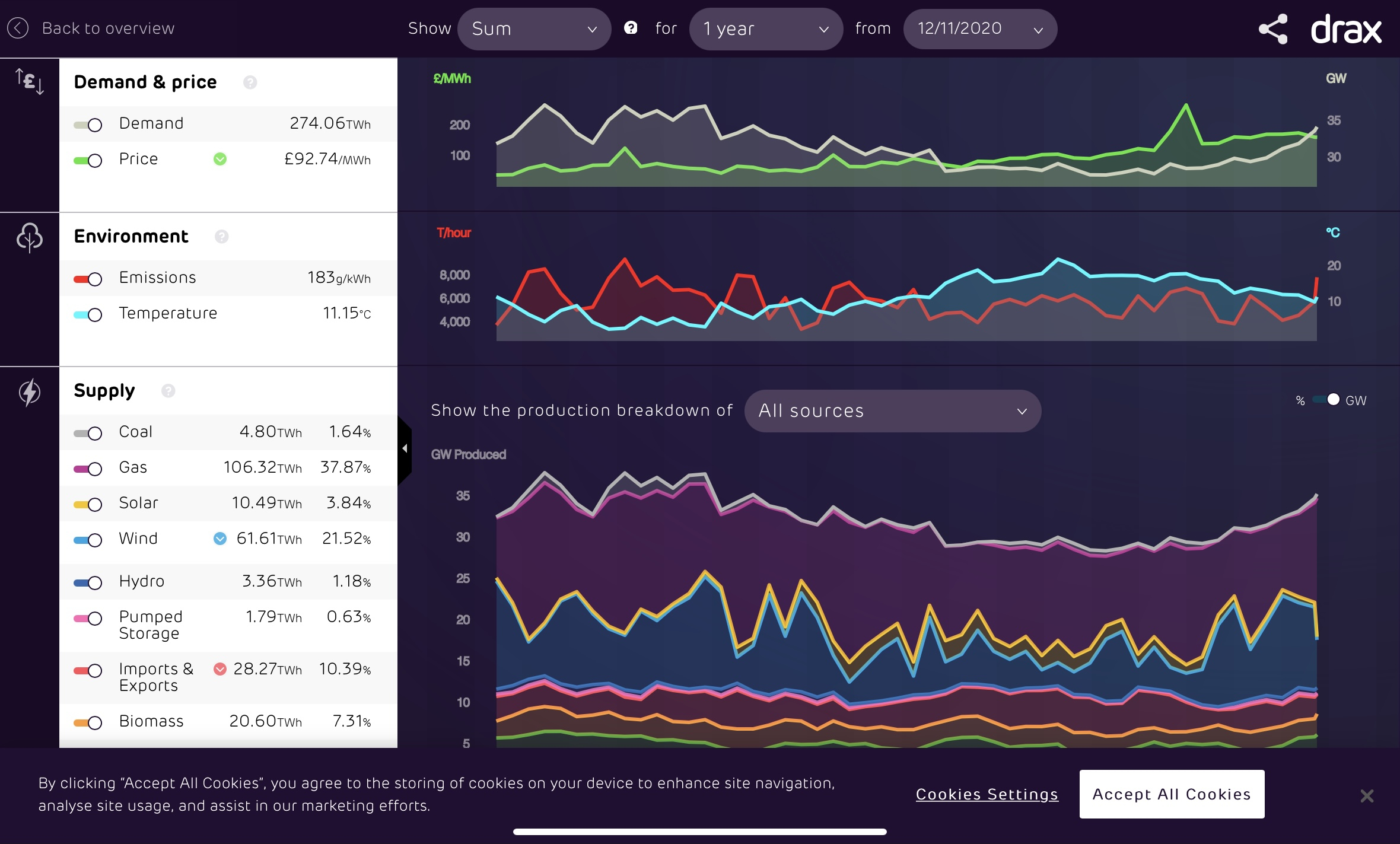
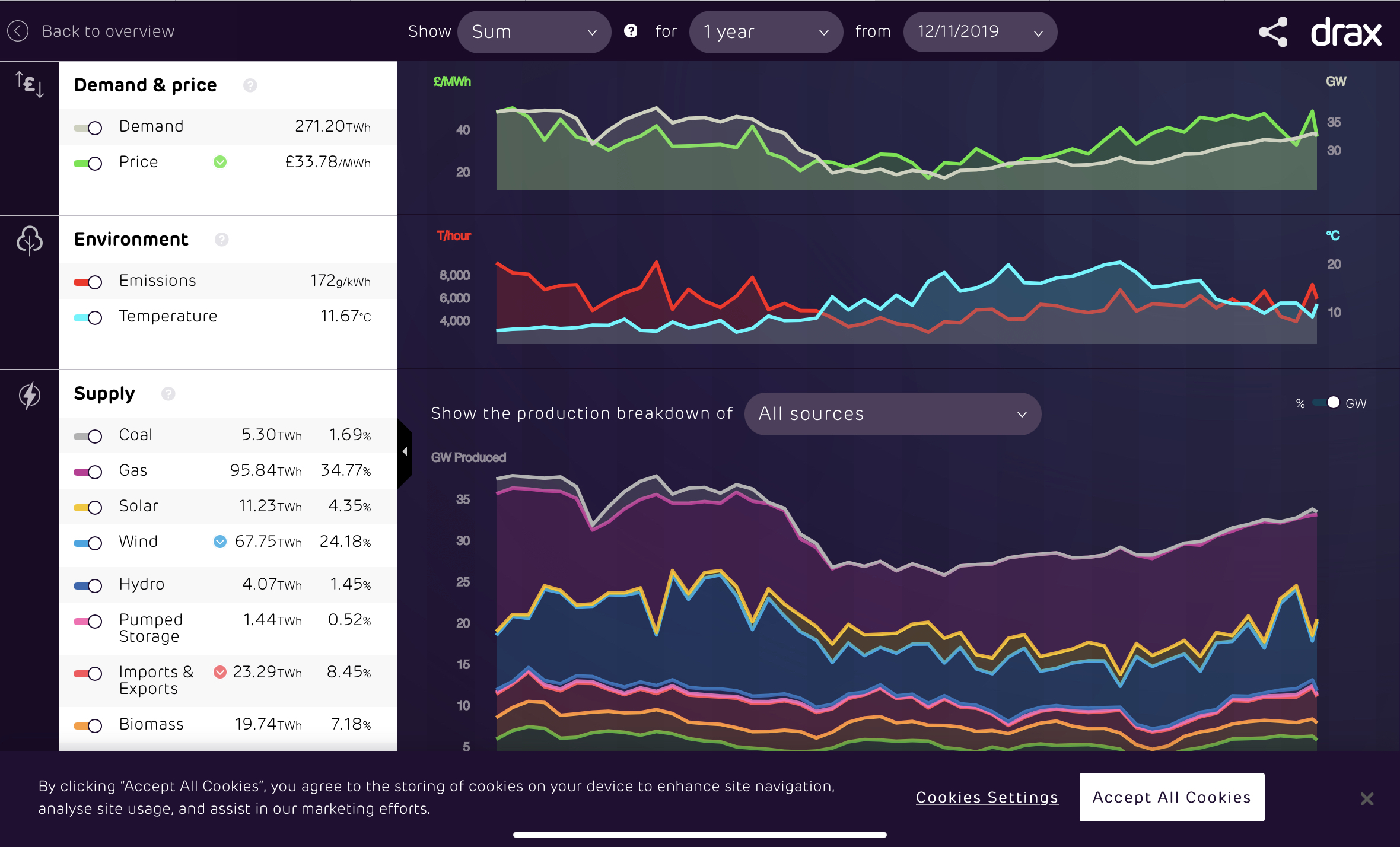
The year-on-year drop in renewable generation was due to exceptionally low wind speeds. According to the Times April-Sep 2021 was the least windy such period for most of the UK and Ireland in 60 years. Stay calm about the year’s unusual wind drought | Register | The TimesJanuary to March 2021 was pretty bad as well with wind averaging just 8.93GW compared to 10.65GW a year earlier.Northern Lincolnshire. 7.8 kWp system, (4.2 kw west facing panels , 3.6 kw east facing), Solis inverters, Solar IBoost water heater, Mitsubishi SRK35ZS-S and SRK20ZS-S Wall Mounted Inverter Heat Pumps, ex Nissan Leaf owner)0 -
Energy use in 2020 was down on 2019. Your question is meaningless.JKenH said:ed110220 said:
That's a pretty bad abuse of marginal emissions theory. It's only appropriate to use it for instantaneous to short term changes where the load changes but the generation system is the same.JKenH said:By and large we use up all the renewably generated energy first so whatever additional load we put on the grid is going to be met by marginal generation. So in theory whenever we switch a light on or plug in a kettle it is supplied by marginal generation (gas/coal). In practice there is inertia in the grid so one kettle in the short term isn’t going to have any impact. There might be a microscopic variation in frequency or voltage but no one is going to be shovelling coal into a boiler or opening a gas valve.
If however we look at things on a macro scale, say we add 100,000 electric cars to the grid, then that is additional demand (c300GWh) and inevitably has to be supplied by marginal generation.Yes, one can argue that the load from the electric cars can be anticipated (not on an individual level but as an average) so might be considered baseload but the bottom line is that if we have a we have a finite renewable energy supply then if there is a mass change of habit (electric car adoption) then that must increase demand for marginal generation. We have therefore to generate an additional 300 GWh from gas or coal more than if we had stuck with our ICE cars. I am not saying we shouldn’t move to electric cars but we are deluding ourselves if we pretend that they aren’t fuelled by marginal generation, i.e. predominately gas and coal.
Ah, some might say, but we are increasing RE generation to meet the extra demand from EVs. Until such time as marginal generation is provided by RE (and that is years away) any extra load we add to the grid will be met by gas and coal (or imports).The reality, though, is that RE generation has stalled. If we look at the last 12 months and compare it with the same period one year earlier we generated just 72TWh of our electricity from wind and solar compared to 78 TWh a year earlier.

(Ab)using it for longer term changes leads to the benefits of adding low carbon electricity being assigned to old uses of electricity, leaving new uses to be thought of as consuming the dirty power. The logic of that would be, say radios being old tech running on nice clean electricity and smart phones being new running on coal power. Clearly that would be absurd, showing why marginal emissions theory is inappropriate for longer term technological changes.
Here's an interesting article that goes into more detail: When to use Marginal Emissions (and when not to) | A New Shade of Green | Sherry Listgarten | Palo Alto Online |
The year-on-year drop in renewable generation was due to exceptionally low wind speeds. According to the Times April-Sep 2021 was the least windy such period for most of the UK and Ireland in 60 years. Stay calm about the year’s unusual wind drought | Register | The Times
1.7 GW of wind has been added from Q2 2019 to Q2 2021 (see Energy Trends: UK renewables - GOV.UK (www.gov.uk)) and at least 4.8 GW of off-shore wind is under construction and expected in the next few years. If we take the average offshore UK capacity factor of 40% (this is a pessimistic assumption as newer farms having larger turbines tend to have higher factors) the 4.8 GW under construction will add 16,819 GWh per year. Taking 200 Wh/km as an average EV consumption and 12,000 km as average distance a UK driver drives per year, I make that enough electricity for about 7 million EVs. Clearly the assumption that EVs are going to be added to an electricity grid that is basically the same as today is wildly inaccurate.Long time no hear. Pleased that my post sparked your interest. It did not pass me by that you felt the need to use terms such as “abuse/abusing” and “wildly inaccurate” in your response.
There is an interesting quote in the Sherry Listgarten article you linked.
“Unfortunately, there is some lack of agreement around which emissions model to use for which purposes, and Lena Perkins says that this can make the metrics vulnerable to “cherry picking”, when people use the metric that makes their initiative look most compelling.”
Yes, I chose a model which supported my point - it would be illogical to do otherwise. I am sure you choose the model that best suits your arguments. I acknowledge there are two points of view on the issue of marginal generation when it comes to EVs. We are unlikely to agree but not a problem, we just see things differently - the world won’t end. Some may follow my logic while others will reject it.
Whatever the reason, wind generation was down year on year (despite the increase in installed capacity you mention), as was solar, yet over the same period we added around 175,000 BEVs and 110,000 PHEVs. Just where did the additional generation come from to charge those cars?
8kW (4kW WNW, 4kW SSE) 6kW inverter. 6.5kWh battery.0 -
Why is it meaningless? I was comparing the year from 12 November 2020, ie the 12 months just past which had 274 TWh energy use with the 12 months from 12 November 2019 - energy use 271TWh. There was a 3TWh rise in consumption, some of which would have been related to the 175,000 BEVs and 110,000 PHEVs added. I had previously suggested 100,000 new BEVs would add around 300GWh demand so the new cars added in this period would contribute in the region of 600GWh annually so let’s say 50% i.e. 300 GWh extra demand in the period. Over the same period there was a 7TWh (79TWh down to 72TWh) fall in wind and solar generation.ABrass said:
Energy use in 2020 was down on 2019. Your question is meaningless.JKenH said:ed110220 said:
That's a pretty bad abuse of marginal emissions theory. It's only appropriate to use it for instantaneous to short term changes where the load changes but the generation system is the same.JKenH said:By and large we use up all the renewably generated energy first so whatever additional load we put on the grid is going to be met by marginal generation. So in theory whenever we switch a light on or plug in a kettle it is supplied by marginal generation (gas/coal). In practice there is inertia in the grid so one kettle in the short term isn’t going to have any impact. There might be a microscopic variation in frequency or voltage but no one is going to be shovelling coal into a boiler or opening a gas valve.
If however we look at things on a macro scale, say we add 100,000 electric cars to the grid, then that is additional demand (c300GWh) and inevitably has to be supplied by marginal generation.Yes, one can argue that the load from the electric cars can be anticipated (not on an individual level but as an average) so might be considered baseload but the bottom line is that if we have a we have a finite renewable energy supply then if there is a mass change of habit (electric car adoption) then that must increase demand for marginal generation. We have therefore to generate an additional 300 GWh from gas or coal more than if we had stuck with our ICE cars. I am not saying we shouldn’t move to electric cars but we are deluding ourselves if we pretend that they aren’t fuelled by marginal generation, i.e. predominately gas and coal.
Ah, some might say, but we are increasing RE generation to meet the extra demand from EVs. Until such time as marginal generation is provided by RE (and that is years away) any extra load we add to the grid will be met by gas and coal (or imports).The reality, though, is that RE generation has stalled. If we look at the last 12 months and compare it with the same period one year earlier we generated just 72TWh of our electricity from wind and solar compared to 78 TWh a year earlier.

(Ab)using it for longer term changes leads to the benefits of adding low carbon electricity being assigned to old uses of electricity, leaving new uses to be thought of as consuming the dirty power. The logic of that would be, say radios being old tech running on nice clean electricity and smart phones being new running on coal power. Clearly that would be absurd, showing why marginal emissions theory is inappropriate for longer term technological changes.
Here's an interesting article that goes into more detail: When to use Marginal Emissions (and when not to) | A New Shade of Green | Sherry Listgarten | Palo Alto Online |
The year-on-year drop in renewable generation was due to exceptionally low wind speeds. According to the Times April-Sep 2021 was the least windy such period for most of the UK and Ireland in 60 years. Stay calm about the year’s unusual wind drought | Register | The Times
1.7 GW of wind has been added from Q2 2019 to Q2 2021 (see Energy Trends: UK renewables - GOV.UK (www.gov.uk)) and at least 4.8 GW of off-shore wind is under construction and expected in the next few years. If we take the average offshore UK capacity factor of 40% (this is a pessimistic assumption as newer farms having larger turbines tend to have higher factors) the 4.8 GW under construction will add 16,819 GWh per year. Taking 200 Wh/km as an average EV consumption and 12,000 km as average distance a UK driver drives per year, I make that enough electricity for about 7 million EVs. Clearly the assumption that EVs are going to be added to an electricity grid that is basically the same as today is wildly inaccurate.Long time no hear. Pleased that my post sparked your interest. It did not pass me by that you felt the need to use terms such as “abuse/abusing” and “wildly inaccurate” in your response.
There is an interesting quote in the Sherry Listgarten article you linked.
“Unfortunately, there is some lack of agreement around which emissions model to use for which purposes, and Lena Perkins says that this can make the metrics vulnerable to “cherry picking”, when people use the metric that makes their initiative look most compelling.”
Yes, I chose a model which supported my point - it would be illogical to do otherwise. I am sure you choose the model that best suits your arguments. I acknowledge there are two points of view on the issue of marginal generation when it comes to EVs. We are unlikely to agree but not a problem, we just see things differently - the world won’t end. Some may follow my logic while others will reject it.
Whatever the reason, wind generation was down year on year (despite the increase in installed capacity you mention), as was solar, yet over the same period we added around 175,000 BEVs and 110,000 PHEVs. Just where did the additional generation come from to charge those cars?
So we had an extra 300GWh demand from EVs and a 7TWh fall in RE generation which to most people would suggest that we had to burn more fossil fuels to charge our EVs.
(For what it’s worth, in the period Nov 2018 to Nov 2019 consumption was 286TWh and wind and solar produced 69 TWh.)Northern Lincolnshire. 7.8 kWp system, (4.2 kw west facing panels , 3.6 kw east facing), Solis inverters, Solar IBoost water heater, Mitsubishi SRK35ZS-S and SRK20ZS-S Wall Mounted Inverter Heat Pumps, ex Nissan Leaf owner)1 -
On an individual basis human behaviour regarding day to day energy use is difficult to predict but over the population as a whole the trends in behaviour are much easier to see and hence predict. National Grid won’t know whether I am going to put 30kWh into my car tonight and more than double my daily consumption but they will have a very good idea what total electricity demand for the country will be.ed110220 said:
Those are probably quite easy to estimate compared with the impacts of human behaviour on demand. They will know how much PV has been installed and then they can use weather forecasts/observations to estimate how much they will be/are generating.Spies said:How do the national grid deal with sources they can't 'see' like domestic solar installations?Northern Lincolnshire. 7.8 kWp system, (4.2 kw west facing panels , 3.6 kw east facing), Solis inverters, Solar IBoost water heater, Mitsubishi SRK35ZS-S and SRK20ZS-S Wall Mounted Inverter Heat Pumps, ex Nissan Leaf owner)0 -
Andrew Neil is right – on climate change, the BBC is short-changing us
What this meant in practice was that every time you turned on the radio or TV, you heard the same message relentlessly repeated, and that message, as Andrew Neil has complained, seemed to come straight from the Greenpeace press office.Here’s the interview you should have heard during Cop26:
Politician, or climate activist, or committed scientist: So, if we cannot limit the rise in global temperatures to less than 1.5 degrees, we can expect more devastating weather events, more hurricanes and flooding and wildfires, and more people will die.
BBC interviewer: In which case, how do we explain the fact that there has been no increase in the frequency of hurricanes in the past 150 years? And that far fewer people die now from weather-related disasters than they did in the 1970s? And that the amount of land consumed by fires worldwide is dropping year on year?
https://www.telegraph.co.uk/tv/0/andrew-neil-right-climate-change-bbc-short-changing-us/
Northern Lincolnshire. 7.8 kWp system, (4.2 kw west facing panels , 3.6 kw east facing), Solis inverters, Solar IBoost water heater, Mitsubishi SRK35ZS-S and SRK20ZS-S Wall Mounted Inverter Heat Pumps, ex Nissan Leaf owner)1 -
Here’s the interview you should have heard during Cop26:
Politician, or climate activist, or committed scientist: So, if we cannot limit the rise in global temperatures to less than 1.5 degrees, we can expect more devastating weather events, more hurricanes and flooding and wildfires, and more people will die.
BBC interviewer: In which case, how do we explain the fact that there has been no increase in the frequency of hurricanes in the past 150 years? And that far fewer people die now from weather-related disasters than they did in the 1970s? And that the amount of land consumed by fires worldwide is dropping year on year?
https://www.telegraph.co.uk/tv/0/andrew-neil-right-climate-change-bbc-short-changing-us/
Like this, you mean? Or this? (Sorry no trendline.)
Or this? (Sorry no trendline.)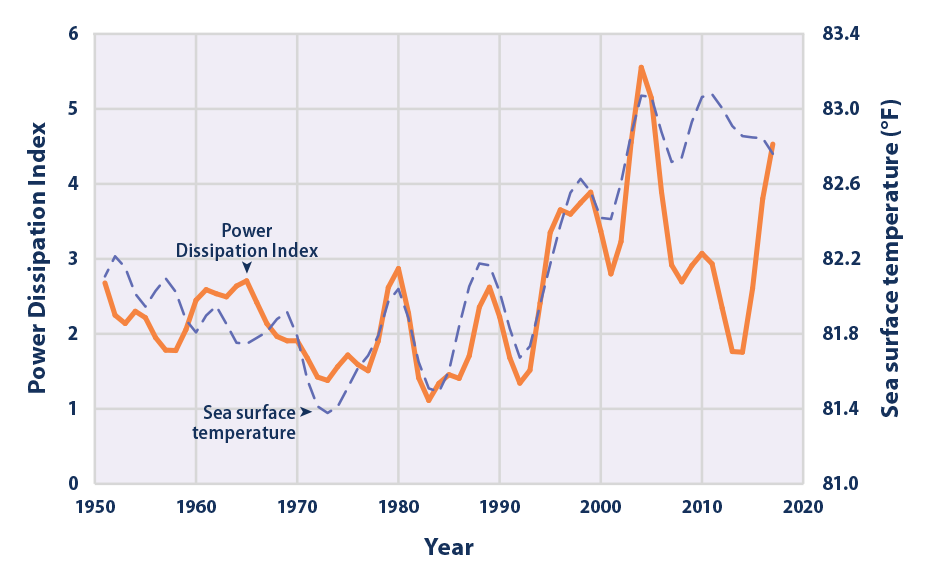
N. Hampshire, he/him. Octopus Intelligent Go elec & Tracker gas / Vodafone BB / iD mobile. Ripple Kirk Hill Coop member.Ofgem cap table, Ofgem cap explainer. Economy 7 cap explainer. Gas vs E7 vs peak elec heating costs, Best kettle!
2.72kWp PV facing SSW installed Jan 2012. 11 x 247w panels, 3.6kw inverter. 34 MWh generated, long-term average 2.6 Os.0 -
Or how about this?
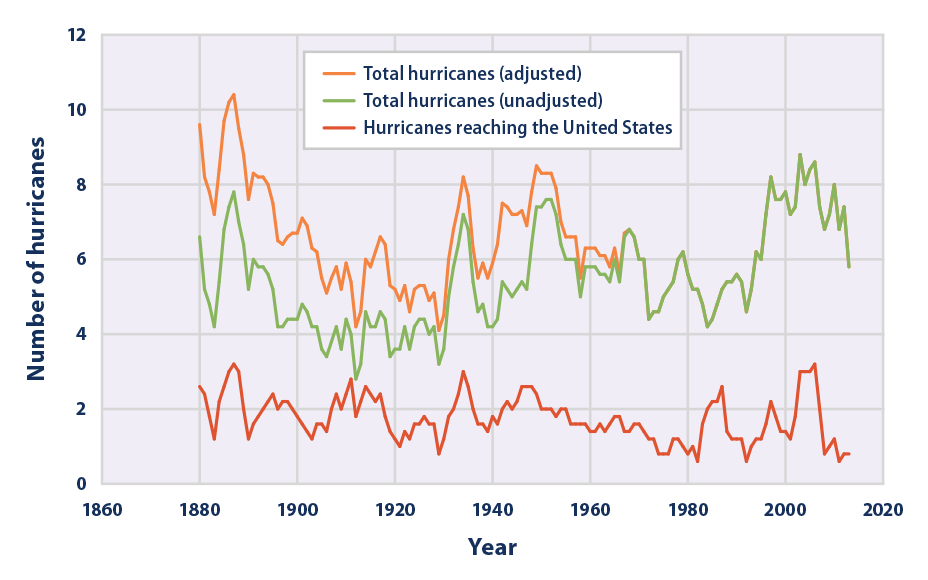
2 -
Or this perhaps.
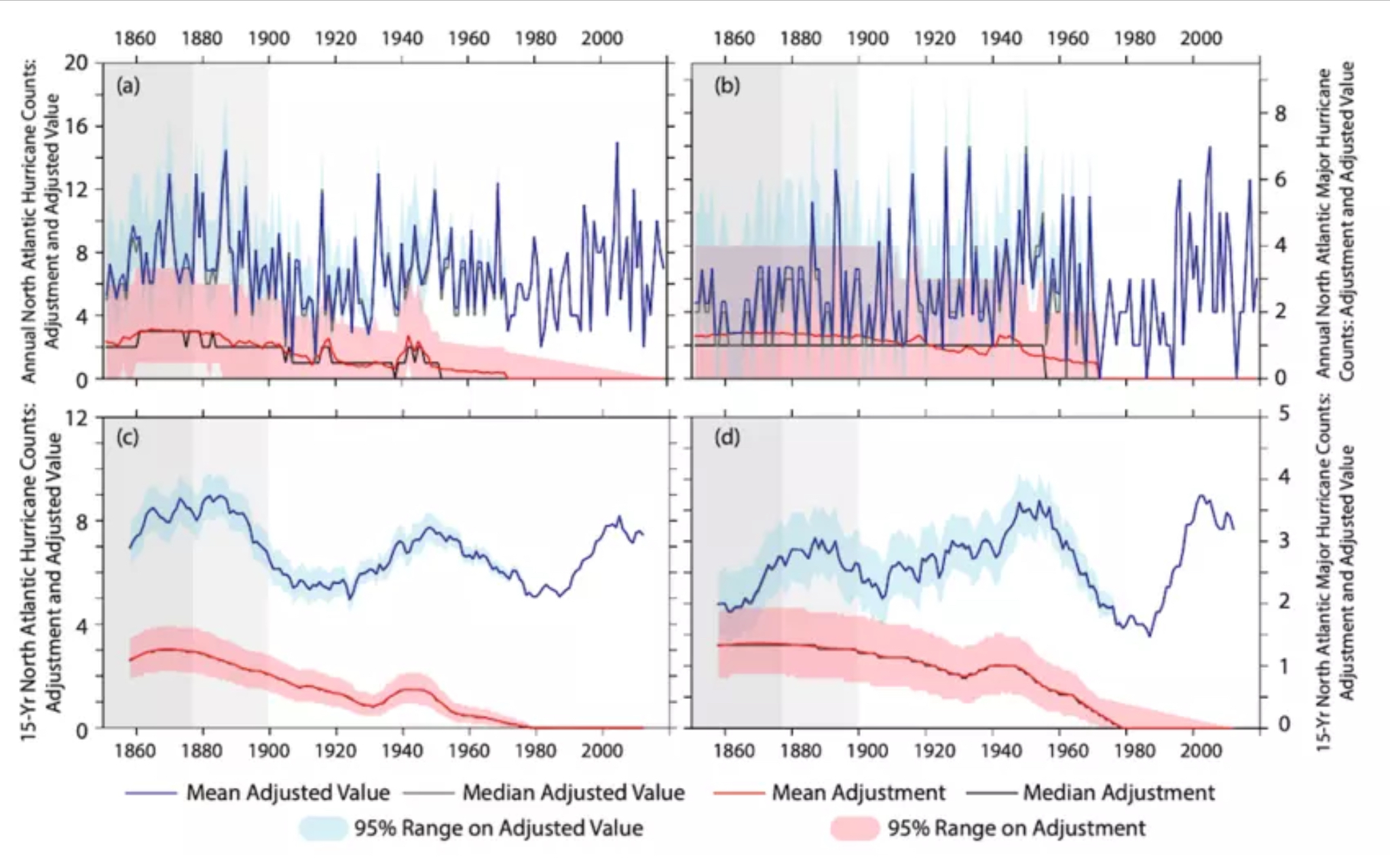 One of the issues with recording of hurricanes is that before satellite data those that didn’t make landfall might have been missed so the figures post, say 1980 are skewed. This chart shows the number of hurricanes adjusted for this.
One of the issues with recording of hurricanes is that before satellite data those that didn’t make landfall might have been missed so the figures post, say 1980 are skewed. This chart shows the number of hurricanes adjusted for this.
There is also the fact that during the 1960s and ‘70s hurricane activity was suppressed by aerosol emissions and the post 1980 rise may just be a reaction to the suppressed levels of a couple of decades earlier.Northern Lincolnshire. 7.8 kWp system, (4.2 kw west facing panels , 3.6 kw east facing), Solis inverters, Solar IBoost water heater, Mitsubishi SRK35ZS-S and SRK20ZS-S Wall Mounted Inverter Heat Pumps, ex Nissan Leaf owner)1 -
While gas prices will likely ease into next year, the dynamics of the power markets will remain challenging for the next few years
Most projections indicate energy prices will rise over the next decade, possibly adding another 50% to current levels. But these price rises will not be uniform: more renewables with near-zero marginal cost means more periods of low or negative pricing.
More price cannibalisation due to low wholesale prices could make un-subsidised renewable energy projects un-viable by the 2030s. At the same time, studies have also shown that despite claims to the contrary, the capex and opex costs of off-shore wind are not falling. This calls into question the future of existing plant as subsidies expire, as well as the chances of financing new projects.
Northern Lincolnshire. 7.8 kWp system, (4.2 kw west facing panels , 3.6 kw east facing), Solis inverters, Solar IBoost water heater, Mitsubishi SRK35ZS-S and SRK20ZS-S Wall Mounted Inverter Heat Pumps, ex Nissan Leaf owner)1 -
If the subsidised price is half or less than the price of nuclear, do we really care about the subsidy?!JKenH said:While gas prices will likely ease into next year, the dynamics of the power markets will remain challenging for the next few years
Most projections indicate energy prices will rise over the next decade, possibly adding another 50% to current levels. But these price rises will not be uniform: more renewables with near-zero marginal cost means more periods of low or negative pricing.
More price cannibalisation due to low wholesale prices could make un-subsidised renewable energy projects un-viable by the 2030s. At the same time, studies have also shown that despite claims to the contrary, the capex and opex costs of off-shore wind are not falling. This calls into question the future of existing plant as subsidies expire, as well as the chances of financing new projects.
I think....0
Confirm your email address to Create Threads and Reply

Categories
- All Categories
- 352.9K Banking & Borrowing
- 253.9K Reduce Debt & Boost Income
- 454.7K Spending & Discounts
- 246K Work, Benefits & Business
- 602.1K Mortgages, Homes & Bills
- 177.8K Life & Family
- 259.9K Travel & Transport
- 1.5M Hobbies & Leisure
- 16K Discuss & Feedback
- 37.7K Read-Only Boards






